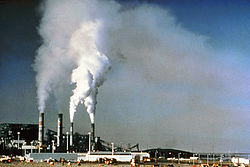2014年5月30日、環境大臣は、北九州市に建設が予定されている「ひびき天然ガス発電所」(160万kW)の 計画段階環境配慮書(※)に意見を表明し、新設によって排出を上回らせることなく、 電力供給先あるいは他社の古い発電所と代替することでCO2を削減することを求めました。 最新鋭の天然ガスコンバインドサイクルでさえも、CO2削減を減らす手立てなく新設は認められないというわけです。
環境大臣、電力業界全体としてのCO2削減を要求
 今回、新しい天然ガスの火力発電所の建設に際して、環境大臣が意見の中で事業者に対して指摘したことは3つあります。 1つは、新設する160万kW分の発電量を、電力供給先ないし他の電力会社における古い発電所を停止させるなどの方法で同程度の発電量と代替し、結果的に電力業界全体としてCO2を減らすこと。 2つめは、電力業界全体の自主的枠組みを早期に構築すること。 3つめは、この発電所が2050年でも運転されていることが想定されることから、二酸化炭素分離回収設備(CCS)の検討を行うこと。 さらに、経済産業省に対しても、国の目標と整合する電力業界全体の実効的な取り組みが確保されるよう、 電気事業者の枠組みの早期構築を促すよう求めています。 環境大臣のこれらの意見は、2013年4月に環境省と経済産業省においてとりまとめられた 「東京電力の火力電源入札に関する関係局長級会議取りまとめ」 (以下、局長級取りまとめ)を根拠にしています。 ここでは、東京電力が電源入札をするにあたって石炭火力発電が新設されることによるCO2排出への対応として、 電力業界全体の自主的な枠組みを構築すること、また、天然ガス火力を超過する分に相当する純増分について 海外での削減にかかる取り組みを行うなどの対策を取ることを求めています。 今回の事業案件は天然ガスですが、環境大臣は同様の意見を付したことになります。 配慮書の次の段階である「方法書」では、どのように環境アセスメントを行うかが示されますが、 環境大臣の意見を受け、事業者が「局長級とりまとめ」にどれだけ忠実に対応し CO2排出削減総量の削減を計画段階で検討するか、注目したいところです。
今回、新しい天然ガスの火力発電所の建設に際して、環境大臣が意見の中で事業者に対して指摘したことは3つあります。 1つは、新設する160万kW分の発電量を、電力供給先ないし他の電力会社における古い発電所を停止させるなどの方法で同程度の発電量と代替し、結果的に電力業界全体としてCO2を減らすこと。 2つめは、電力業界全体の自主的枠組みを早期に構築すること。 3つめは、この発電所が2050年でも運転されていることが想定されることから、二酸化炭素分離回収設備(CCS)の検討を行うこと。 さらに、経済産業省に対しても、国の目標と整合する電力業界全体の実効的な取り組みが確保されるよう、 電気事業者の枠組みの早期構築を促すよう求めています。 環境大臣のこれらの意見は、2013年4月に環境省と経済産業省においてとりまとめられた 「東京電力の火力電源入札に関する関係局長級会議取りまとめ」 (以下、局長級取りまとめ)を根拠にしています。 ここでは、東京電力が電源入札をするにあたって石炭火力発電が新設されることによるCO2排出への対応として、 電力業界全体の自主的な枠組みを構築すること、また、天然ガス火力を超過する分に相当する純増分について 海外での削減にかかる取り組みを行うなどの対策を取ることを求めています。 今回の事業案件は天然ガスですが、環境大臣は同様の意見を付したことになります。 配慮書の次の段階である「方法書」では、どのように環境アセスメントを行うかが示されますが、 環境大臣の意見を受け、事業者が「局長級とりまとめ」にどれだけ忠実に対応し CO2排出削減総量の削減を計画段階で検討するか、注目したいところです。
CO2排出量は石炭>天然ガス。石炭にはもっときびしく
CO2削減の観点から、天然ガス火力発電所でも、事業計画段階からきびしい対策をもとめる今回の環境大臣からの意見。 これに対し、既に計画段階配慮書が公開された東京電力が計画中の福島県の2か所の石炭火力発電所、 そして常陸那珂ジェネレーションが茨城県那珂郡に建設予定の発電所、 鹿島パワーが茨城県鹿島市に計画している発電所は、 いずれも石炭火力であるにもかかわらず、CO2について今回環境大臣が指摘したような対策は示されていません。 これらの事業者には、「局長級とりまとめ」はどれほど重視されているのでしょうか。 いや、そもそも意識しているのでしょうか(まさか、無視…ではないですよね?) 言うまでもなく、石炭火力の場合は、CO2削減対策についてずっと厳しく評価されなければなりません。 これらの石炭火力発電所の配慮書への環境大臣の意見は重要なものとなりそうです。 ※計画段階環境配慮書とは 計画段階環境配慮書とは、環境アセスメントのプロセスの一環で、一定規模以上の発電所などを建設する事業者に作成が義務づけられ、事業に関して最初に公表されるものです。 事業の実施に伴う大気環境、生態系への影響や環境への負荷について調査するもので、CO2も評価対象になっています。意見は環境大臣だけでなく、配慮書の公開中はだれでも意見書を出すことができます。
On May 30th 2014, the Minister of the Environment commented on the planning phase environmental impact statement* (read here, Japanese only) for the Hibiki natural gas-fired power plant (1600MW), set to be built in Kitakyushu City, Fukuoka. The Minister stressed three points to utility companies in reducing CO2 emissions for new natural gas-fired power plants.
 First, the minister urged utilities to reduce their overall power sector’s CO2 emissions by substituting electricity generated from a newly developed 1600MW plant for the equivalent power generation by older plants, which requires other companies to end operations at older plants. Second, the minister requested the electric power industry to form a voluntary framework as early as possible. Third, the minister also requested utilities to consider CCS (carbon capture and storage) technology given that the power plants are anticipated to still be in use by 2050. Furthermore, the minister requested that the Ministry of Economic, Trade and Industry (METI) urge the electric power industry to form the voluntary framework at an early stage in order to guarantee that the electric power industry is consistent with national climate targets.
First, the minister urged utilities to reduce their overall power sector’s CO2 emissions by substituting electricity generated from a newly developed 1600MW plant for the equivalent power generation by older plants, which requires other companies to end operations at older plants. Second, the minister requested the electric power industry to form a voluntary framework as early as possible. Third, the minister also requested utilities to consider CCS (carbon capture and storage) technology given that the power plants are anticipated to still be in use by 2050. Furthermore, the minister requested that the Ministry of Economic, Trade and Industry (METI) urge the electric power industry to form the voluntary framework at an early stage in order to guarantee that the electric power industry is consistent with national climate targets.
These comments are based on MoE and METI’s agreement concerning TEPCO’s thermal power bid in April 2013 (read more here, Japanese only). The agreement requested that the electric power industry form a voluntary framework, and take measures to keep additional emission levels on par with emissions from natural gas. This time, the Minister of Environment gave a similar statement on the Hibiki power plant project even though the plant is a natural gas plant, not coal. However, the minister took the same position concerning CO2 emission reductions.
It is worth paying attention to how closely Saibu Gas, the utility set to operate the plant, follows MoE and METI’s agreement of adopting CO2 mitigation measures during the planning phase. For the 2 coal-fired power plant set to be built in Fukushima by TEPCO as well as the 2 plants that resulted from their bid (both to be built in Ibaraki), their planning phase impact statement do not reflect the measures put forth by MoE and METI. Judging from this, it is quite doubtful if utilities will attach any importance to the agreement by MoE and METI or if there are even aware of any such remarks.
The upcoming scope document (which will detail how the environmental assessment will be conducted) for the Hibiki power plant project is sure to be heavily evaluated by both MoE and Japanese NGOs. Regardless, it is imperative that the CO2 reduction measures of coal-fired power plants should be strictly evaluated. The comments by the Environment Minister concerning the impact statements of these coal-fired power plants is key for the next step in the process.
※As part of the environmental assessment process, corporations are obligated to draw up an environmental impact statement before establishing a new power plant that exceeds a certain size. It is the first document that investigates the project’s impact on the atmosphere and ecosystems. This process is open for comments by not only the Minster of the Environment, but also the public for a set period of time.

